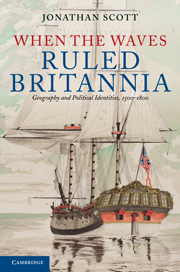Book contents
- Frontmatter
- Contents
- List of figures
- List of maps
- Preface: Geography and the sea
- List of abbreviations
- Introduction: Britain's island idea
- 1 Community of water
- 2 Queen of Sparta
- 3 The discipline of the sea
- 4 Ark of war
- 5 Blowing a dead coal
- 6 The British empire in Europe
- 7 The world in an island
- 8 Anti-continentalism
- 9 What continent?
- Conclusion: floating islands
- Appendix: Duck Language (1724)
- Bibliography
- Index
Conclusion: floating islands
Published online by Cambridge University Press: 05 June 2012
- Frontmatter
- Contents
- List of figures
- List of maps
- Preface: Geography and the sea
- List of abbreviations
- Introduction: Britain's island idea
- 1 Community of water
- 2 Queen of Sparta
- 3 The discipline of the sea
- 4 Ark of war
- 5 Blowing a dead coal
- 6 The British empire in Europe
- 7 The world in an island
- 8 Anti-continentalism
- 9 What continent?
- Conclusion: floating islands
- Appendix: Duck Language (1724)
- Bibliography
- Index
Summary
Our islands lost again, all earth one island,
And all our travel circumnavigation.
Allen Curnow, DiscoveryBy the early nineteenth century the British empire included many islands in the Mediterranean and Asia as well as the Caribbean and Pacific. In 1808 this drew from G. F. Leckie another rumination upon Britain's accomplishment in emulating the maritime achievements of Athens and Rhodes. If maritime empire was not new, after 1815 the scale of British naval power was. We should thus not be surprised to see the imperial archipelago further reimagined as a fleet. This floating archipelago had a specific genesis in English republican experience and its intellectual and cultural anticipations. In 1627–8 it was a swarm of bees. Under the republic it was ‘Of floting Islands a new Hatched Nest; A Fleet of Worlds, of other Worlds in quest.’ Acts 10 and 11 of the reign of William and Mary referred to Newfoundland as ‘a great English ship moored near the Banks’.
To describe the empire as a fleet was not simply to emphasize its global – the equivalent today would be planetary – reach (‘A Fleet of Worlds’). It was to set it again, against the empire of Sparta, and with that of Athens, as a thing in motion. Michel Foucault captured this mobile universality thus: ‘The boat is a floating piece of space, a place without a place, that exists by itself, that is closed in on itself and at the same time is given over to the infinity of the sea.
- Type
- Chapter
- Information
- When the Waves Ruled BritanniaGeography and Political Identities, 1500–1800, pp. 194 - 197Publisher: Cambridge University PressPrint publication year: 2011



